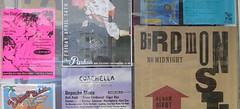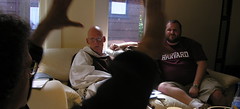Google Book Search in the Garden: Folkways and folk history

Yesterday morning a camera crew with Google Book Search showed up in my garden and asked me some questions about the way digitalized archives are changing the relationships between knowledge and society. I described my own work: how the full-text search capabilities for eighteenth- and nineteenth-century books are allowing scholars to recognize historical patterns about subtle variables (like walking) that would have never shown up before. Pedagogy is changing too: we're able to introduce hundreds of undergraduates at a time to rare books that previously only ten to twelve advanced students in a seminar would have ever seen.
But the big changes will be those that take place well outside the academy. For most of its existence, the academy has seen itself as a field for training the leaders of the future and the children of the elite. Only these happy few were granted access to the library, the archive, and the manuscripts. Sometimes a diligent outside researcher could make his way in: but more often the traditional archives required letters of recommendation for a researcher to even set foot inside the library's hallowed halls. These constraints are all the more real outside of America, where letters of reference are taken vary seriously; French historians describe the long process of waiting for access to the Bibliothéque Nationale; Jennie Johnson, a Fulbright Fellow in China, has told me about a several-month wait for access to the university library, after which she was told that without a PhD she would not qualify for access to the English-language archives. Throwing the doors of the library open means a world of access not only for scholars, but more importantly, for those who have never had access at all.
From the white towers of academia it's easy to wonder whether clerks, consultants, and bus-drivers really want access to sixteenth-century incunabulae and government memos after all -- don't we have to threaten our undergrads with bad grades to get them into the library? Common wisdom holds that only academics will participate in the digital turn of rereading the archive, that the hoi polloi only care about news and fandom. But I predict a different path.
Digitizing the world's archives, not merely the great books but also the government records and ephemera, puts academic-level power in the hands of ordinary citizens. While library research has limited importance to most of them, other kinds of research form an organic feature of ordinary folkways in contemporary America. When church-going Christians meet for their weekly or monthly Bible study, they rarely meet with only the Bible in their hands. More often, they come with some appendix: another translation (or three), a book of poetry that enlightens a related train of wisdom, a manual of Bible history that provides some richer context for making sense of the past. These meetings can turn into furious exchanges of information and perspective, as participants strive to understand more deeply the lessons of scripture. Evangelical blogs are now buzzing about the possibilities of comparing nineteenth-century biblical literature, and republishing a list of relevant books compiled by one scholar in particular. The poetry, history, and legacy of Christian history is being expanded for these people, and so is the opportunity to debate.
Gardeners also check the historical record. Associations of seed-savers were plowing through ancient Burpee catalogues of seeds long before the internet republished them, searching for evidence of tomato and green bean strains that had since been discontinued by corporate seed producers. Many of the original strains had been bred to better survive particular regional conditions -- low water and high heat, or the clay soils of Texas, for example -- and many were bred for "heirloom" qualities of flavor and color once prized but then forgotten in the frenzy for mass-production farming. Garden manuals from the past, out of copyright and now searchable on Google, offer another nursery of new ideas for the small-scale and sustainable gardening community.
Similarly, conspiracy theorists of assassination -- the group with the most significant popular following -- have traditionally circulated among themselves facsimiles of government reports, not only from the Civil Rights era, but also from earlier periods of American political history thought to illuminate a tradition of political corruption and media manipulation at the highest level. On internet forums and blogs, the flood of report-sharing spirals, as conspiracy theorists and their debunkers compare contemporary news stories, published histories, government documents, and republished photographs, accusing each other (and the press) of photoshopping and otherwise distorting the historical record. As the digitized historical archive gives them more material, the participants have access to a far wider class of evidence from which to assemble their picture of a historical tradition of government corruption.
These kinds of folk-research are going to change, just as surely and certainly as academic research is changing. History, often the monopoly domain of academics, also exists wherever geneaologists recite the narrative of their family history and wherever union leaders examine the relationship between politics and public opinion. Usually history with poor sources produces bad story-telling: incoherent and non-persuasive; and this is one reason why academic historians have kept their role as mediator for so long. Access to sources offers a chance for folk-history to become real history, and that means the proliferation of believable, grounded, persuasive historical accounts about all the things the folk care about -- Bible research, sustainable agriculture, and political corruption included. That new kind of history represents a very powerful trajectory indeed.










